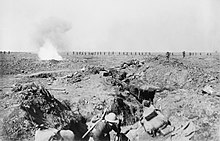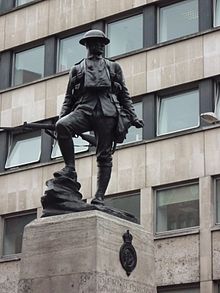2nd (City of London) Battalion, London Regiment (Royal Fusiliers)
However, there was a protracted controversy over its foundation: the Lord Lieutenant of Middlesex, the Marquis of Salisbury, was opposed to any unit that would 'place upon its class the stamp of inferiority to another' and refused to accept it even when Shelley proposed to change its concept from a purely artisan corps to include clerks from banks, printing houses and lawyers' offices.
At one point seven of Routledge's sons were serving in the corps.The 46th Middlesex gained its own Honorary Colonel in 1877 when Lt-Col Sir Charles Russell, 3rd Baronet, VC, MP for Westminster and formerly of the Grenadier Guards, was appointed to the position.
In the docks C Company boarded and seized the SS Hanna Larsen, a German-registered vessel moored suspiciously close to a vulnerable wooden railway bridge; the crew were interned for the duration of the war.
A small number of officers and men ruled medically unfit or who had not volunteered for overseas service were left at Tufton Street to begin recruiting a reserve battalion.
After re-equipping with charger-loading Long Lee-Enfield rifles and 1914 pattern equipment and reorganising into the four-company establishment, 1/2nd Londons joined GHQ Reserve at Saint-Omer on 25 January for further training.
On 10 March the BEF launched the Battle of Neuve Chapelle, and 17th Bde was ordered to carry out a diversion by capturing the hamlet of l'Epinette in the German front line opposite.
[36][40][42][43] In September the battalion moved into the dilapidated La Brique trenches, and with the help of a reinforcement draft were able to improve them, and carried out a diversion with smoke and rifle fire to assist an attack elsewhere.
[27][50][51] After the reformed division had shaken down, 169th Bde moved south on 7 May and went into a hutted camp at Halloy to train for its part in the forthcoming 'Bug Push' (the Battle of the Somme).
[25][26][69][70][71][72] The division made a second attempt on its other objectives on 18 September, but the battalion (now only 7 officers and 481 ORs, even after receiving a draft of 50 men) did not take part, only relieving the QWR in the Combles and Q trenches after the action.
[25][26][81][82][83] During a period out of the line, in reserve and training, Lt-Col Attenborough left the battalion due to ill-health and Maj J.P. Kellett (who had joined the regiment in August 1914) was promoted to succeed him.
[25][26][86][87][88] Apart from a short spell back in the Cojeul trenches (9–20 June), when C and D Companies opened heavy fire on a series of German-held shellholes being attacked by 3rd Division, the battalion was out of the line until the end of July.
[25][26][104][105][106] While the Germans continued their offensive in other sectors, 56th Division spent the following weeks in reserve, often at 5 minutes' notice to go into action, or preparing defences round Arras.
Seeing this, Lt-Col Kellett gathered all the available men, chiefly from HQ, together with some machine guns, and improvised a flank guard to allow the advance to continue to Farmer's trench.
At about midday the battalion intelligence officer, reconnoitring ahead, reported to Kellett that Sensée alley was unoccupied by the enemy and would provide a covered way up to the Hindenburg Line.
Leaving B Company at the junction of Farmer's trench and Sensée alley to provide a flank guard towards Croisilles, the rest of the battalion moved up under cover and made good its objectives in the Hindenburg Line.
The advance was carried out under intense machine gun fire form in front and both flanks, but reached the outskirts of Bullecourt, Lt-Col Kellett being wounded.
The Canadians were held up at the village of Marquion and then 56th Division's Royal Engineers (REs) and pioneer battalions had to fight to clear the enemy from the far bank before they could lay their assault bridges.
The defences were later extended to Isna, some 300 miles (480 km) below Minya, and C and D Companies including the Nag Hammadi detachment were moved there on 13 March, where they were joined by Lt-Col Houlder and Battalion HQ.
At the time of the renumbering, the 58th Division was carrying out coast defence duties in East Anglia, but on 10 July 1916 it concentrated at Sutton Veny for final training on Salisbury Plain.
The battalion was then forced to jump off at 05.30 on 26 October from a line of flooded craters under enemy shellfire, which caused heavy casualties: A Company went into action under the command of a 19-year-old sergeant, the only officer or NCO left standing.
The 2/2nd Company, reinforced by some dismounted cavalry and 114 ORs just arrived from England, took up positions covering the Quierzy bridges until the Royal Engineers could blow them up; the expected German attack was then driven off.
174th Brigade was given the initial objective of capturing Malard Wood, after which 173rd Bde would pass through to take the vital Chipilly Ridge overlooking a bend in the River Somme and flanking the battlefield.
Elements of 2/2nd Londons reached Prince Reserve trench, but the brigade was too weak to clear all the machine gun posts in the villages and the battalion found itself almost surrounded.
Early next morning the Germans fired a heavy concentration of gas shells into Bléharies, causing numerous casualties both to troops and civilians, and forcing B and D Companies on the edge of the village to evacuate the contaminated ground.
The regimental history records that 2/2nd Londons was disbanded at Stambruges on 26 February 1919, but in fact cadres of all units in 58th Division continued at Leuze until they sailed home in June 1919.
[226][236][237] On 28 March 1945 12th Royal Fusiliers (PTC) lapsed into suspended animation, the administrative staff being transferred to the Parachute Regiment for duty with No 2 Army Air Corps Infantry Training Centre.
[240][241][242] When Anti-Aircraft Command was disbanded in 1955 there was a major reduction in the number of AA units, and 624th LAA absorbed 526th (Mixed) LAA/Searchlight Regiment, RA (27th London Electrical Engineers), which formed R Company.
[250] The roll of honour is now in the Royal Fusiliers' Regimental Chapel in St Sepulchre-without-Newgate in Holborn,[251] The 58th Divisional Memorial, depicting a wounded horse sculpted by Henri Gauquie, is at Chipilly.
[253] The 2nd London Regiment and 9th Royal Fusiliers were awarded the following Battle honours:[9][11][27][221] Second Boer War: South Africa, 1900–02 World War I: Somme, 1916, '18, Albert, 1916, '18, Guillemont, Ginchy, Flers-Courcelette, Morval, Le Transloy, Arras, 1917 '18, Scarpe, 1917 '18, Bullecourt, Ypres, 1917 Langemarck, 1917, Menin Road, Polygon Wood, Passchendaele, Cambrai, 1917, St Quentin, Villers Bretonneux, Amiens, Bapaume, 1918, Hindenburg Line, Épehy, Canal du Nord, Valenciennes, Sambre, France and Flanders 1915–18, Gallipoli 1915–16, Egypt, 1915–16.
World War II: Djebel Tebega, North Africa 1943, Salerno, St Lucia, Battipaglia, Teano, Monte Camino, Garigliano Crossing, Damiano, Anzio, Gothic Line, Coriano, Croce, Valli di Comacchio, Argenta Gap, Italy 1943–45 The honours in bold were those chosen to be emblazoned on the King's colour.
















